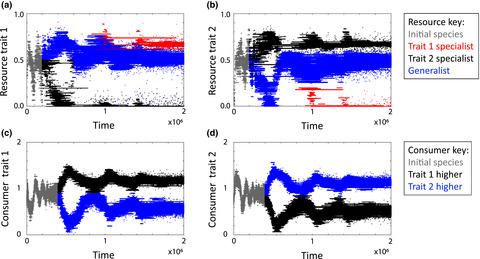当前位置:
X-MOL 学术
›
Ecol. Lett.
›
论文详情
Our official English website, www.x-mol.net, welcomes your
feedback! (Note: you will need to create a separate account there.)
Coevolution, diversification and alternative states in two‐trophic communities
Ecology Letters ( IF 7.6 ) Pub Date : 2020-11-17 , DOI: 10.1111/ele.13639 Tobin D. Northfield 1, 2 , Jörgen Ripa 3 , Lucas A. Nell 4 , Anthony R. Ives 4
Ecology Letters ( IF 7.6 ) Pub Date : 2020-11-17 , DOI: 10.1111/ele.13639 Tobin D. Northfield 1, 2 , Jörgen Ripa 3 , Lucas A. Nell 4 , Anthony R. Ives 4
Affiliation

|
Single‐trait eco‐evolutionary models of arms races between consumers and their resource species often show inhibition rather than promotion of community diversification. In contrast, modelling arms races involving multiple traits, we found that arms races can promote diversification when trade‐off costs among traits make simultaneous investment in multiple traits either more beneficial or more costly. Coevolution between resource and consumer species generates an adaptive landscape for each, with the configuration giving predictable suites of consumer and resource species. Nonetheless, the adaptive landscape contains multiple alternative stable states, and which stable community is reached depends on small stochastic differences occurring along evolutionary pathways. Our results may solve a puzzling conflict between eco‐evolutionary theory that predicts community diversification via consumer–resource interactions will be rare, and empirical research that has uncovered real cases. Furthermore, our results suggest that these real cases might be just a subset of alternative stable communities.
中文翻译:

两营养型社区的共同进化,多样化和替代状态
消费者与其资源物种之间的军备竞赛的单特征生态进化模型通常显示出抑制作用,而不是促进了社区多样化。相反,通过对涉及多个特质的军备竞赛进行建模,我们发现,当特质之间的权衡成本使对多个特质的同时投资更加有利或成本更高时,军备竞赛可以促进多元化。资源和消费者物种之间的共同进化会为每种物种生成一个适应性景观,其配置提供了可预测的消费者和资源物种套件。但是,适应性景观包含多个替代的稳定状态,而达到哪个稳定社区取决于沿进化路径发生的微小随机差异。我们的结果可能解决了生态进化论之间的一个令人费解的矛盾,即通过消费者与资源之间的相互作用来预测社区多样化的生态进化理论与已经发现真实案例的实证研究之间是罕见的。此外,我们的结果表明,这些实际案例可能只是替代性稳定社区的一部分。
更新日期:2021-01-11
中文翻译:

两营养型社区的共同进化,多样化和替代状态
消费者与其资源物种之间的军备竞赛的单特征生态进化模型通常显示出抑制作用,而不是促进了社区多样化。相反,通过对涉及多个特质的军备竞赛进行建模,我们发现,当特质之间的权衡成本使对多个特质的同时投资更加有利或成本更高时,军备竞赛可以促进多元化。资源和消费者物种之间的共同进化会为每种物种生成一个适应性景观,其配置提供了可预测的消费者和资源物种套件。但是,适应性景观包含多个替代的稳定状态,而达到哪个稳定社区取决于沿进化路径发生的微小随机差异。我们的结果可能解决了生态进化论之间的一个令人费解的矛盾,即通过消费者与资源之间的相互作用来预测社区多样化的生态进化理论与已经发现真实案例的实证研究之间是罕见的。此外,我们的结果表明,这些实际案例可能只是替代性稳定社区的一部分。











































 京公网安备 11010802027423号
京公网安备 11010802027423号